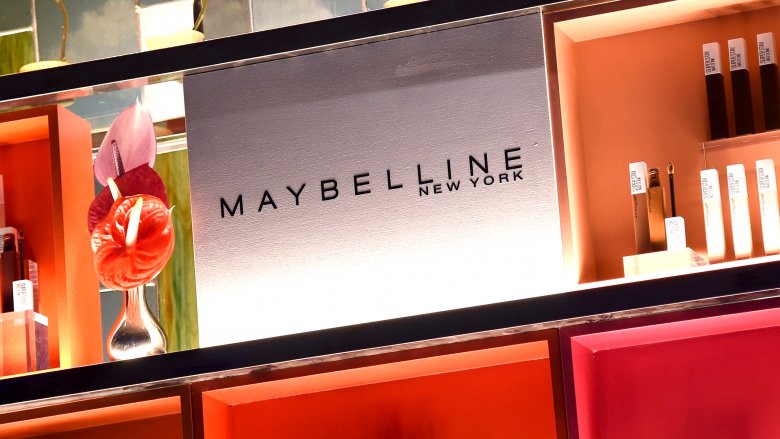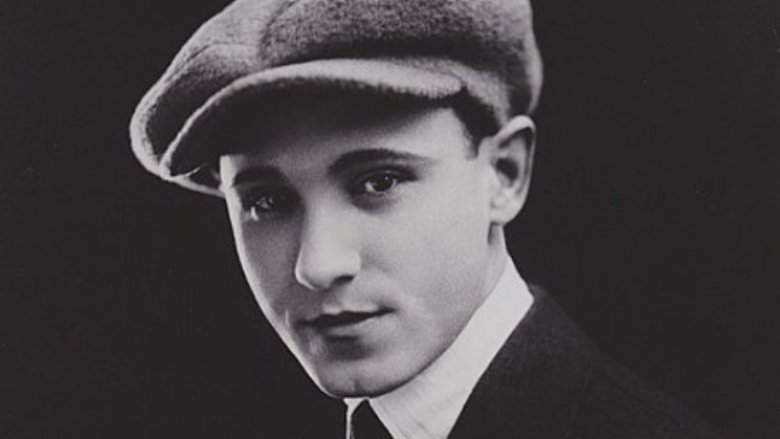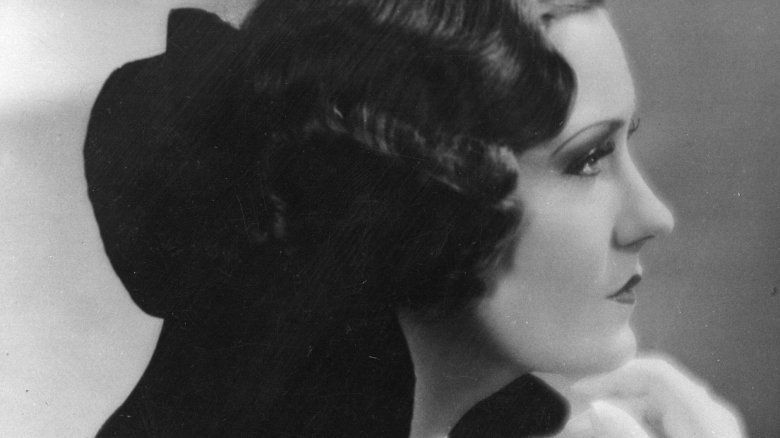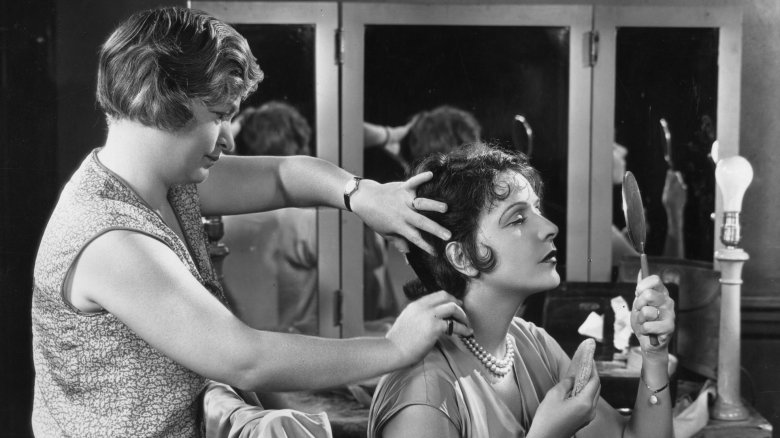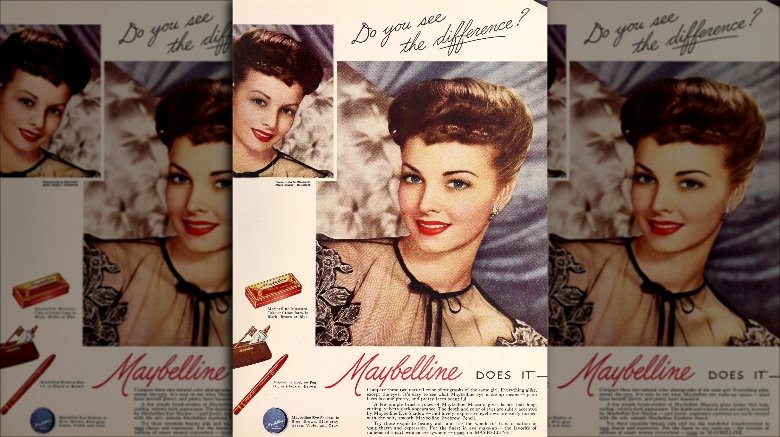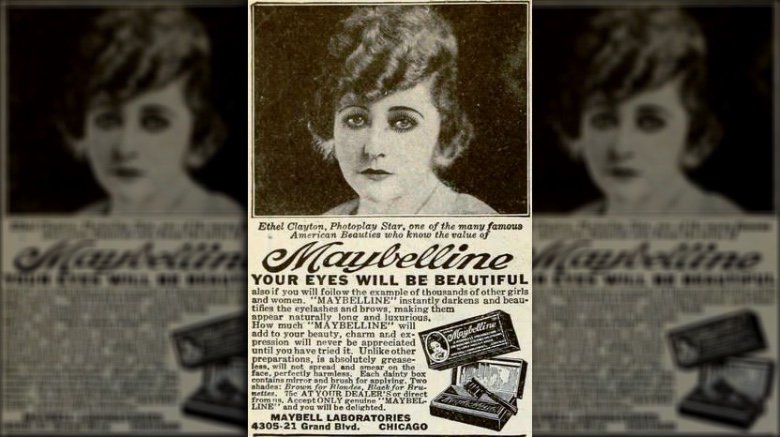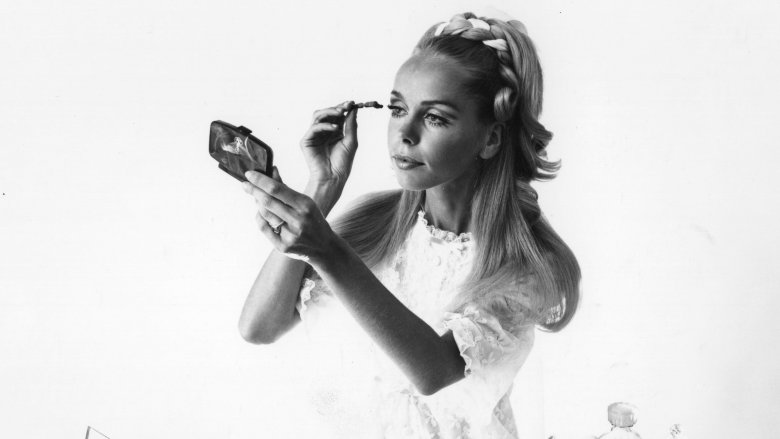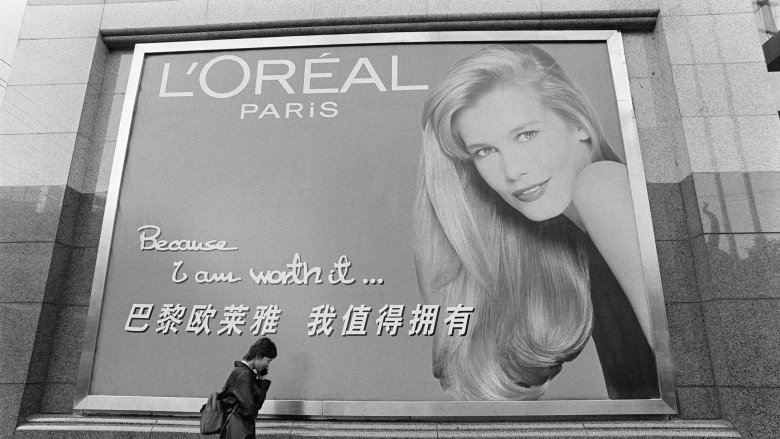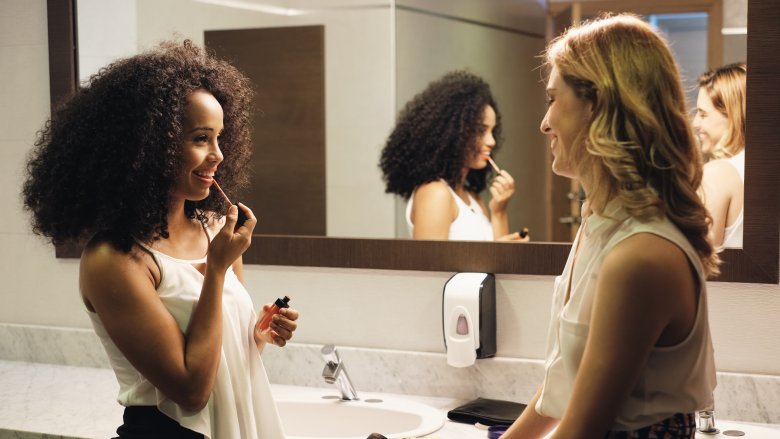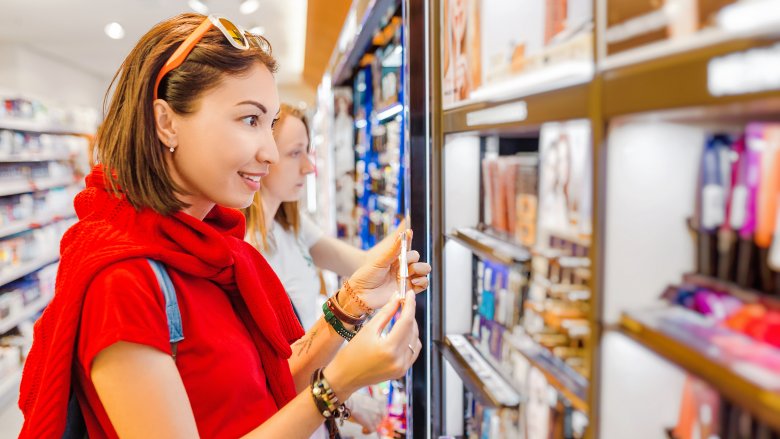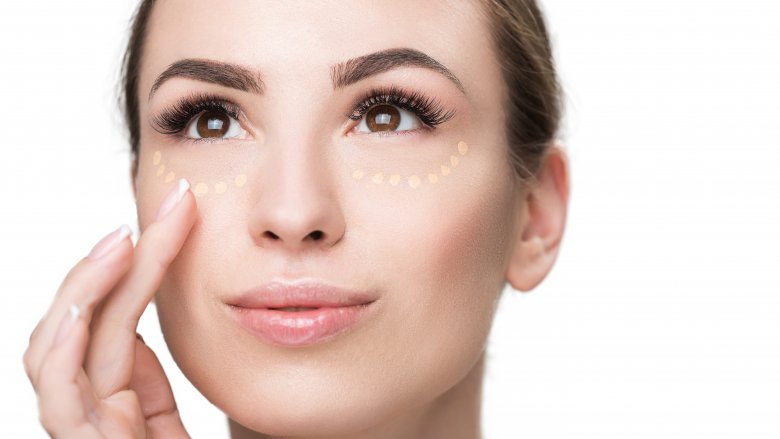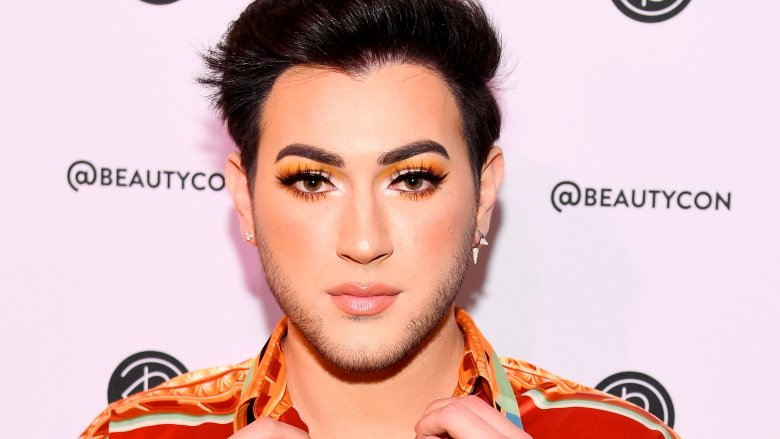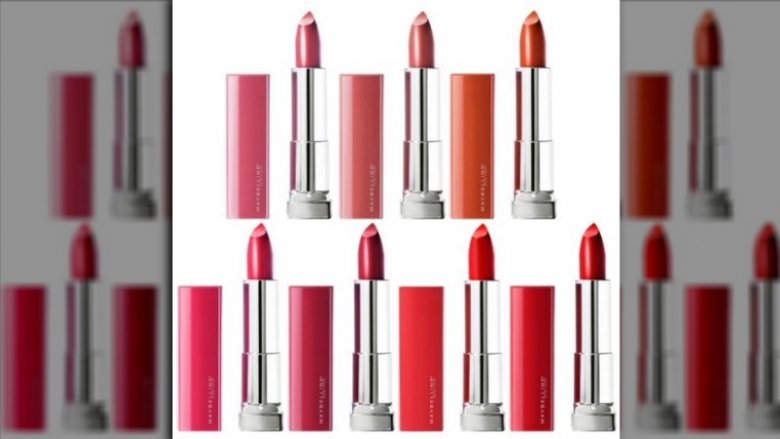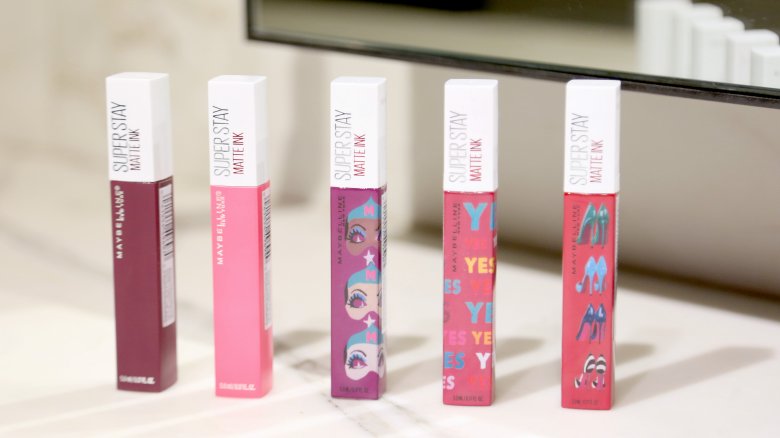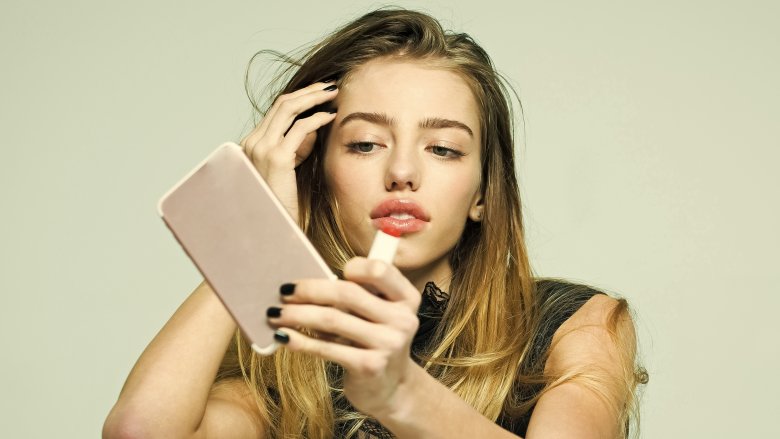The Untold Truth Of Maybelline
When you think of Maybelline, images of bubblegum pink and lime green tubes of mascara probably flood your mind first. Great Lash Mascara, the brand's cult classic cosmetic, has developed a wide consumer base — from budget-conscious shoppers to the professionals — since it first hit the market.
"It's still a staple in my kit, all of these years later," makeup artist Neil Scibelli told The Oprah Magazine. "The brush grips and curls the lashes easily, and the formula dries really quick." Makeup artist Nick Barose told the publication that it's also great for adding "volume without the clumps or crunchy texture." It's no wonder, then, that over 20 million of these mascaras are sold annually — or one tube every 1.7 seconds, according to Yahoo! Lifestyle.
Maybelline sells more than just mascara, though. According to the brand itself, Maybelline New York offers "more than 200 products" and is "the number one global cosmetics brand." Are you surprised? There's a lot more about Maybelline that you haven't heard. Here's the truth.
Maybelline: A love story
Before there was Maybelline New York, there was Maybel Williams. "In 1913, young Chicago chemist Thomas Williams had a dilemma," the cosmetic brand begins its story on its website. "His older sister, Maybel, was in love with a man who was in love with someone else." So, what did Maybel do? She turned to makeup, of course. Well, she turned to the cosmetics that were available to her at the time — namely, petroleum jelly. She used the product to enhance her natural lashes and eyebrows, but Thomas came up with an even better idea.
"Her brother decided to help her increase her allure by adding carbon dust to the petroleum jelly, which darkened her lashes and brows more dramatically," shared Maybelline. "The product worked." Within two years, Maybel won over her man and Thomas went on to create the company "named after the bride and her favourite beauty aid," Vaseline.
Maybelline introduced the world's first mascara
Although Thomas Williams came up with a mascara-like product spontaneously, it took a partnership with pharmaceutical company Parke, Davis & Co. to really get the ball rolling. According to the Made in Chicago Museum, the team's first product was called Lash-Brow-Ine before eventually becoming Maybelline.
In time, Williams secured an office — which he called "Maybell Laboratories" — near his home in Chicago. He started to market Lash-Brow-Ine in newspapers and sold the cosmetic exclusively through mail order. According to the cosmetic company, Williams next came up with Maybelline Cake Mascara — "the first modern eye cosmetic made for everyday use." It, too, was only available for purchase through mail order, but it became "so popular that women began to ask for it in drugstores."
In the 1920s, Maybelline helped spearhead the "youthful, flapper, fashion trend of dramatic makeup," Maybelline New York explained. The brand soon created an eyebrow pencil in the color red, followed by other colorful eyeshadows and liners. Maybelline then took its advertising to the next level and became the first-ever cosmetic company to advertise on the radio.
Maybelline created a new market of makeup-wearers
Marketing makeup to women may not sound like a revolutionary idea today, but, back in the early 1900s, it was a challenge. Cosmetics were "left to the theater and the women outside the pale of good society," Williams said in an interview in 1934 (via Made in Chicago Museum). "Up to comparatively recent times very few women used rouges, lipsticks, eye beautifiers and other quite obvious improvers of facial appearance." He continued, saying, "Here the real job began, because my capital was very small, and while my product was good, I was faced with the job of selling women on the idea that it was perfectly moral to use eye beautifiers."
By utilizing silent film stars in his Maybelline advertisements, Williams was able to demonstrate to women what their lashes could look like and, thus, helped makeup extend beyond the cinema. "My job was to make women more conscious of their eyes and the possibilities of making them more alluring; to break down prejudice," the founder explained, "and of course, to sell my product." And that's exactly what he did.
Maybelline was the first of its kind in many ways
"Tom Lyle [Williams] took Maybelline out of the classifieds and put it into dime stores so the average American girl could have easy access and it was affordable," Sharrie Williams, the founder's great-niece and author of The Maybelline Story: And the Spirited Family Dynasty Behind It, told the Made in Chicago Museum. Instead of selling their original 75-cent Cake Mascara in stores, Maybelline created a 10-cent version — which Sharrie called "the Depression size" — for retail purposes.
Making products accessible to every woman was far from the only way Maybelline changed the makeup game, though. Although it is an industry standard today, Maybelline's mascaras were among the first to be presented in an upright display — aka "carded merchandising" — as opposed to piled on a shelf or counter. Maybelline also propelled "before and after" advertisements into the mainstream and was among the earliest to earn the Good Housekeeping Seal of Approval.
Maybelline's original catchphrases weren't so catchy
"Maybe she's born with it. Maybe it's Maybelline." It's the catchphrase we all know, but it wasn't the company's first one. In fact, Maybelline had several early slogans — and many of them didn't exactly roll off the tongue. A Maybelline advertisement from 1918 (via Made in Chicago Museum) read, "Beautiful eyelashes and eyebrows make beautiful eyes; beautiful eyes make a beautiful face." Yes, that's four beautifuls in one sentence.
According to The Maybelline Story: And the Spirited Family Dynasty Behind It by Sharrie Williams, Maybelline would also go on to use the phrase "sensibly priced" for a good many years. Over time, the two-word slogan morphed into a slightly longer but very similar "quality, yet sensibly priced." It wasn't until the 1950s that Maybelline would release a slogan that had nothing at all to do with price: "Maybelline, preferred by really smart women the world over."
According to the Made in Chicago Museum, Williams long believed that quality makeup was as good as "being born with it." However, it wasn't until the '90s that Maybelline adopted its iconic slogan.
Maybelline changed hands in the '60s
By 1964, Maybelline was thriving. However, its founder was not. "Tom Lyle [Williams] was now 70, and was not well," Sharrie Williams, Thomas Williams' great-niece and author of The Maybelline Story: And the Spirited Family Dynasty Behind It, told the Made in Chicago Museum. "The loss of his partner [Emery Shaver] was devastating. He began looking for a buyer." Three years later, Plough Inc. bid $136 million for Maybelline and Williams accepted.
"Tom Lyle [Williams] had incorporated Maybelline in 1954, but the stock was only divided among the family and the employees who had been loyal to Maybelline since the beginning," Sharrie explained. "Even the stock boy received one million dollars. A large portion was given to The Goodwill and CARE."
The new company promised to keep Maybelline in Chicago, but that promise was quickly broken. Sharrie said her great-uncle was "heartbroken" upon seeing his former employees were being let go. "It was painful for Tom Lyle to see his baby now being run without him at the helm," she added. Maybelline's headquarters was quickly moved to Memphis, Tenn. and manufacturing later began in Arkansas.
Maybelline changed ownership again in the '90s
In 1990, Maybelline was acquired by Wasserstein Perella & Company, which The New York Times described as "a New York merchant bank." But another company had its eye on the brand. "Maybelline is a brand we have liked very much and have watched for a number of years," Guy Peyrelongue, chief executive of the L'Oréal subsidiary Cosmair, told the publication. By the mid '90s, Cosmair had become one of the biggest cosmetics company in the United States and was responsible for brands like Giorgio Armani and Lancome. Soon enough, L'Oréal did indeed purchase Maybelline, and, by 1997, the label was, as AdAge put it, "ready for some serious global expansion."
Sheri Baron, president of Maybelline's agency Gotham, told the publication at the time: "This is the first time L'Oréal has made an acquisition of an American company and will use the leadership of the brand, including the agency, outside the U.S." This decision has certainly paid off. As of this writing, Maybelline, which is still under the L'Oréal umbrella, is available in over 120 countries worldwide.
Maybelline still relies on old-school advertising
Since Maybelline was founded back in the 1910s, the company has utilized many forms of advertising. From newspapers to radio to television, the label has pretty much tried it all. Even in the digital age, Maybelline has found a way to inspire "offline conversations" about their brand, Brad Fay, chief commercial officer of analytics firm Engagement Labs, explained in an article for Marketing Dive. Such conversations "soared" in the first half of 2018, Engagement Labs found. But just how is Maybelline doing that?
"Maybelline may focus on social media, but it's doing so in a way that motivates consumers to talk about the brand offline too," Fay explained. "Its integrated marketing strategy is increasing brand sharing, which is the extent to which people are sharing or talking about a brand's marketing or advertising, influencer interest and conversation volume offline as well as online." Through their use of compelling images, free samples, and celebrity and influencer partnerships, Maybelline is able to not only get us to share products online, but bring them up in conversations with friends and family.
Maybelline consumers are some of the most loyal shoppers
Advertising may help Maybelline's bottomline, but where would the beauty company be without consumer loyalty? Thankfully for Maybelline, the makeup company has some of the most loyal customers out there. After surveying shoppers, digital agency Corra Research found that Maybelline, as well as Neutrogena and L'Oréal, "earned high marks for both long-term users and loyalty." It may surprise you to learn that millennials are more loyal to Maybelline than they are to brands like MAC or Urban Decay. Baby boomers, too, stick with Maybelline over classic labels like Estee Lauder, Clinique, and Avon. In fact, when analyzing brand loyalty by generation, Maybelline was considered second only to CoverGirl by millennials and baby boomers alike.
Even professional makeup artists swear by Maybelline staples. And that doesn't just mean mascaras, but also foundations, lip tints, and even eyeliners and eyebrow pencils. Clearly, Maybelline provides what makeup lovers want in their products.
We're all wild about Maybelline concealer
Just as the pros like a wide variety of Maybelline products so, too, does the average consumer. According to digital agency Corra Research's comprehensive study, Maybelline's blushes, bronzers, concealers, and foundations were the second most-used cosmetic products of any brand. The study noted, "For eye products like eyeliner, eyeshadow, brow pencils, and mascara, Maybelline was the most used by women, followed by CoverGirl and Revlon."
One of Maybelline's most-beloved products outside of their mascaras is the Instant Age Rewind Eraser Dark Circles Treatment Concealer. According to a Maybelline press release cited by Allure, this concealer was not only named the number one in the mass (budget-friendly) makeup category in 2018, but also the top of the prestige (luxury) market. Oh, and did we mention that you can it get for under $10? Well, you can.
Even supermodels wear the stuff. "I have used this many times on Gigi [Hadid] solely for the purpose of perfecting the skin without using foundation," Maybelline global makeup artist Erin Parsons revealed in a statement to the publication. "I am able to cover blemishes and under-eye darkness using two different tones." Sold.
Maybe HE'S born with it. Maybe it's Maybelline.
In January 2017, Manny Gutierrez (aka YouTube's Manny MUA) cryptically tweeted, "Maybe HE'S born with it" along with a winking face emoji. By then, though, many of his fans had already heard the news. As Glamour reported a day earlier, Maybelline announced a partnership with the ever-popular beauty guru for its Colossal Big Shot mascara. This marked two big firsts for the label: partnering with an online beauty influencer and partnering with a male ambassador. In a statement provided to the publication, Gutierrez said he was "thrilled to be able to work with a global brand like Maybelline that is recognizing male influencer talent and is willing to shine a spotlight on it."
In an interview with PopSugar, Gutierrez further revealed that it felt "amazing" to join the likes of other Latinx Maybelline ambassadors like Adriana Lima. He continued, saying, "I love feeling that culture is represented, especially as a male and a Latino in the beauty world — that is such an unheard-of thing. So I feel like it's a huge honor to be included in such a high-profile group of lovely ladies who are also Latina."
Maybelline sells lipsticks for all
In 2019, Maybelline released its Color Sensational Made For All Lipstick. According to the product's description, the company crafted the cosmetic "using specially selected pigments" that were "tested on 50 diverse skin tones."
Maybelline went into more details about the process on Instagram. "Over a span of 2 days, 5 makeup artists conducted 2,500 evaluations and tested 50 different women to find their perfect shade of red," the brand revealed. For under $9, you can purchase any of the seven shades, which range from Spice For Me, a deep burnt orangey shade, to a brighter pink color called Fuchsia For Me. But are they actually as versatile as promised?
As of this writing, the product sits at 4.4 stars on Ulta's site and 91 percent of consumers say they'd recommend the product to a friend. Glamour staffers who tried out the shades shared their responses, which ranged mostly from likes to even a "l-o-o-o-ve." Maybelline is so sure consumers will love the lipsticks that they even come with a money-back guarantee, according to Business Insider.
Is Maybelline cruelty-free?
"L'Oréal does not test any of its products or any of its ingredients on animals and has been at the forefront of alternative methods for over 30 years," L'Oréal Group states on its official site. This is true of Maybelline, too, as it is a L'Oréal-owned label. However, there's more to the story. PETA claims that Maybelline is still among the beauty brands that tests on animals and thus says you "don't need Maybelline's cruelly produced items to feel pretty."
Although L'Oréal itself does not test its products on animals in the United States or elsewhere, their products are sold in China, where, as L'Oréal Group states, "the health authorities still require and carry out animal testing for certain products." Brands that are not sold in China have maintained their "cruelty-free" status, but Maybelline is one of their labels that "cannot have a 'cruelty-free' logo due to the cosmetics regulation in China." According to the company, L'Oréal is "the most active company working with the Chinese authorities towards a total elimination of animal testing."
A virtual Maybelline makeover
Let's be real. Buying makeup can be fun, sure, but it can also be a frustrating process. Concealers and foundations have a way of looking like the perfect shade in the bottle and then somehow magically transform into being two shades lighter or darker once it comes time for application. Thanks to all the wonderful technological advancements, though, you can now try on makeup without actually having to scour through shade after shade at the drugstore.
Maybelline's Virtual Makeovers promises to help you find the right products for you personally by enabling you to virtually try on everything from blush to lipstick. Their Foundation Finder can help you match a product to your actual skin tone. And, thanks to the Maybelline Brow Play Studio, you can even change the shape and thickness of your brows with the click of a button. What better way to figure out if the bushy brow trend will work for you or if, you know, you'll turn into a full-on werewolf.
